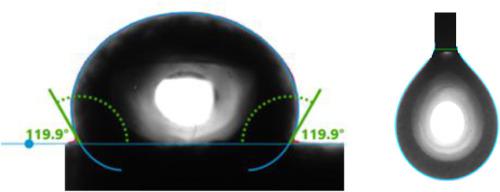Journal of Petroleum Science and Engineering ( IF 5.168 ) Pub Date : 2020-07-27 , DOI: 10.1016/j.petrol.2020.107673 Nurudeen Yekeen , Eswaran Padmanabhan , Hesham Abdulelah , Sayed Ameenuddin Irfan , Oluwagade Adenike Okunade , Javed Akbar Khan , Berihun Mamo Negash

|
In this study, previous literature that discussed CO2/brine interfacial tension and wettability of rock/CO2/brine systems were critically reviewed. Using a shale core from Malaysian formation, laboratory experiments were conducted to extend the scope of available data for CO2/brine interfacial tension (IFT) and contact angles of shale/CO2/brine system, as well as shale/oil/brine system to elevated pressures (8 MPa–22 MPa), temperatures (80 °C–180 °C), and NaCl concentrations (0 wt% - 7 wt %), that are representative of downhole conditions. HPHT (high pressure, high temperature) drop shape analyzer (DSA100) instrument was employed for the contact angles and IFT measurements. The CO2/brine IFT was measured using the pendant drop method while the sessile drop/captive bubble techniques were used to measure the advancing and receding contact angles respectively. Correlations were developed for predicting changes in contact angles and CO2/brine IFT as a function of changing temperature, pressure and salinity. Results showed that the crude oil advancing and receding contact angles for shale/oil/brine system decreased with increasing temperature and salinity, but slightly increased with pressure. The brine advancing and receding contact angles of shale/CO2/brine system increased with increasing pressure and salinity, but decreased with increasing temperature. Conversely, the CO2/brine IFT increased with increasing temperature and salinity, but decreased with increasing pressure. The simulated and experimental values showed reasonable consistency with R2 values of 98% and 99% gotten from the statistical fits of the contact angles values. Precisely, at 80 °C and 7 wt% NaCl concentration, the shale surface became strongly CO2-wet, with brine advancing contact angles of 139.92°, 156.06°, and 162.63° when the pressure reached 18 MPa, 20 MPa, and 22 MPa respectively. At similar salinity conditions and 10 MPa, significant increment in CO2/brine IFT from 36.50 mN/m to 47.54 mN/m occurred with increasing temperature from 80 °C to 180 °C. Such wettability modification of the rock surface and change in IFT at elevated temperature, pressure and salinity will greatly influence hydrocarbon recovery, as well as CO2 containment security in Malaysian unconventional shale formation.
中文翻译:

储层条件下CO 2 /盐水界面张力和岩石润湿性:马来西亚地层黑页岩以往研究和案例研究的综述
在这项研究中,对讨论CO 2 /盐水界面张力和岩石/ CO 2 /盐水体系的润湿性的先前文献进行了严格审查。使用来自马来西亚地层的页岩岩心,进行了实验室实验,以扩展CO 2 /盐水界面张力(IFT)和页岩/ CO 2 /盐水系统以及页岩/油/盐水系统接触角的可用数据范围压力(8 MPa–22 MPa),温度(80°C–180°C)和NaCl浓度(0 wt%-7 wt%)可代表井下条件。使用HPHT(高压,高温)液滴形状分析仪(DSA100)仪器进行接触角和IFT测量。一氧化碳2使用悬滴法测量/盐水IFT,而使用无滴/俘获气泡技术分别测量前进和后退接触角。建立了相关性以预测接触角和CO 2 /盐水IFT随温度,压力和盐度变化的变化。结果表明,页岩/油/盐水体系的原油前进和后退接触角随温度和盐度的升高而降低,但随压力的升高而略有升高。页岩/ CO 2 /盐水体系的盐水前进和后退接触角随压力和盐度的增加而增加,但随温度的升高而减小。相反,CO 2/盐水的IFT随温度和盐度的升高而增加,但随压力的升高而降低。模拟值和实验值显示出合理的一致性,R 2值分别为98%和99%(从接触角值的统计拟合得出)。精确地,在80°C和7 wt%NaCl浓度下,当压力达到18 MPa,20 MPa和22时,页岩表面变成强烈的CO 2湿润,盐水前进接触角为139.92°,156.06°和162.63°。 MPa。在相似的盐度条件和10 MPa下,CO 2显着增加当温度从80°C升高到180°C时,发生I / brine IFT从36.50 mN / m到47.54 mN / m。岩石表面的这种润湿性改变以及高温,高压和盐度下IFT的变化将极大地影响碳氢化合物的回收以及马来西亚非常规页岩地层中CO 2的安全性。



























 京公网安备 11010802027423号
京公网安备 11010802027423号